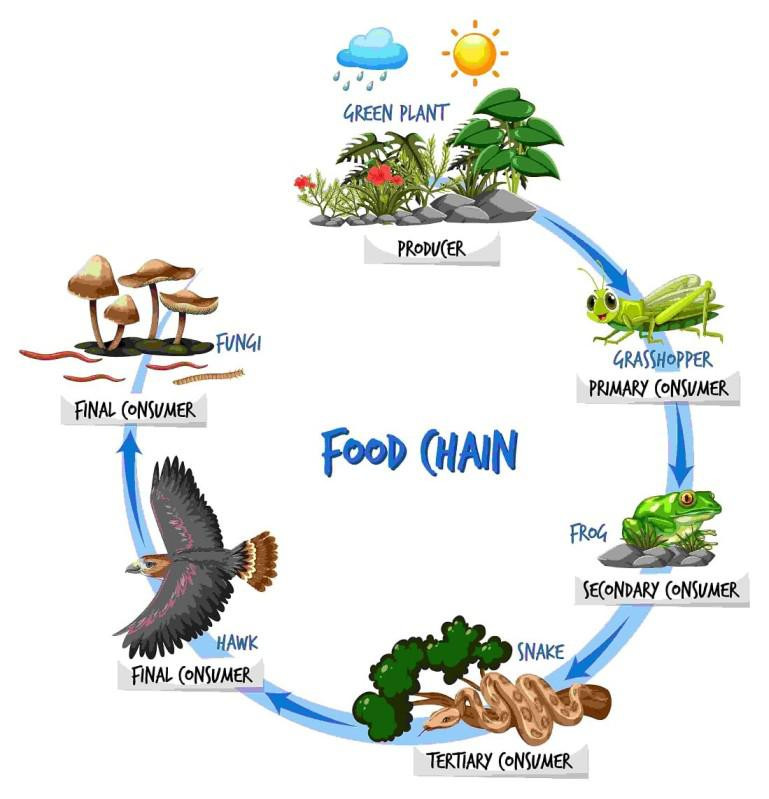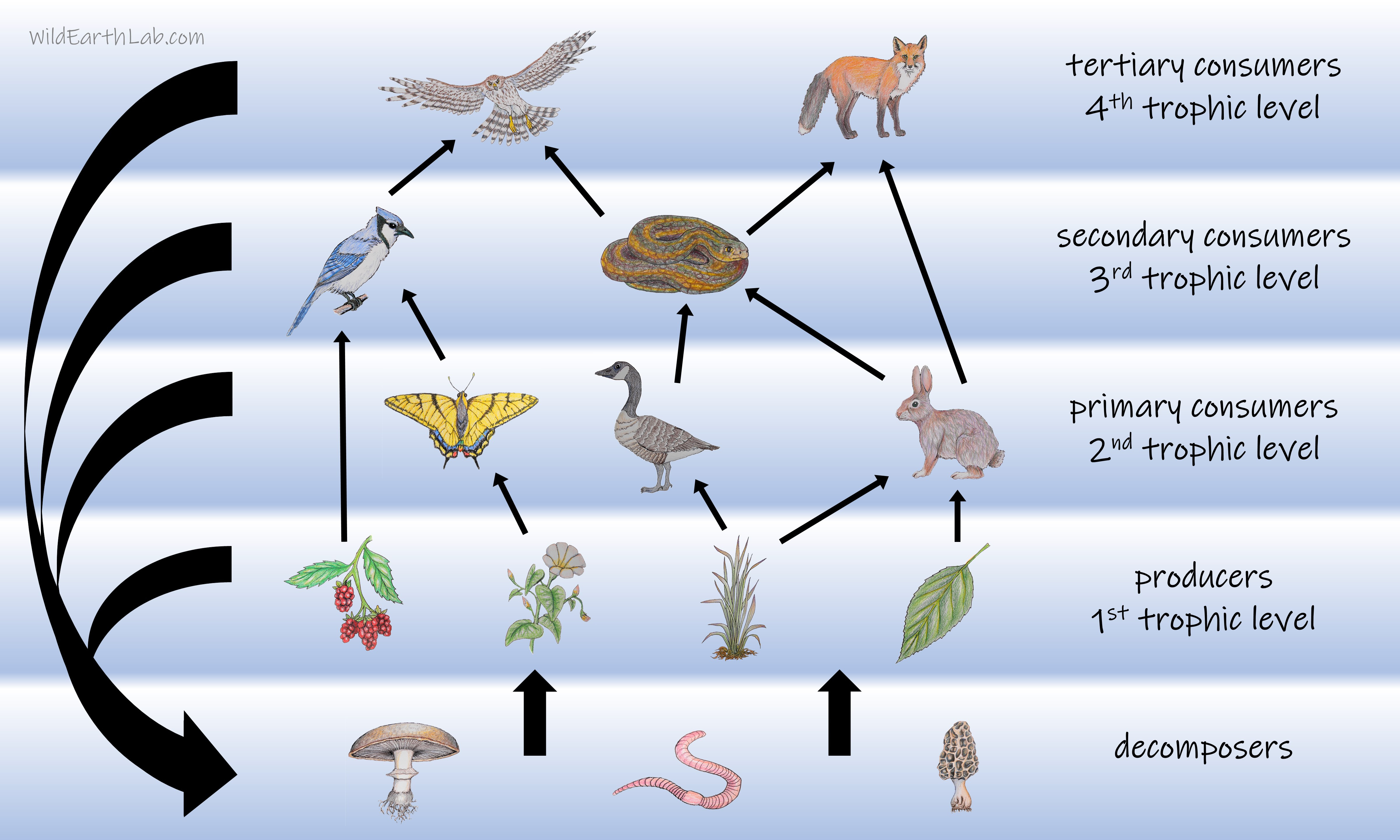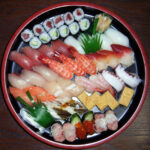The concept of energy flow within an ecosystem is fundamental to understanding ecology. Both food chains and food webs are used to illustrate this flow, mapping out how energy and nutrients are transferred between different organisms. While often used interchangeably, food chains and food webs represent distinct levels of complexity in ecological interactions. A food chain offers a simplified, linear pathway of energy, tracing a single sequence of who eats whom. In contrast, a food web presents a more holistic and intricate view, illustrating the interconnectedness of multiple food chains within an ecosystem. This article will delve into the essential differences between food chains and food webs, highlighting their unique characteristics and significance in ecological studies.
What is a Food Chain?
A food chain is a linear sequence that depicts how energy and nutrients are transferred from one organism to another in an ecosystem. It begins with producers, typically plants or algae, which convert sunlight into energy through photosynthesis. These producers form the base of the food chain. Next come primary consumers, herbivores that feed directly on producers. Following them are secondary consumers, carnivores or omnivores that prey on primary consumers. This sequence can continue with tertiary consumers and even higher levels, each feeding on the level below it. Each stage in this sequence is known as a trophic level. The energy transfer is unidirectional, moving upwards through the chain. Decomposers, like bacteria and fungi, play a crucial role by breaking down dead organisms from all trophic levels, returning vital nutrients to the ecosystem, though they are not always explicitly shown within the linear food chain itself.
Characteristics of a Food Chain
Food chains, while simplified representations, highlight several key aspects of energy flow in ecosystems:
- Linear Energy Pathway: Energy flows in a straight line from one organism to the next, demonstrating a direct transfer of energy.
- Trophic Levels: They clearly define trophic levels, illustrating the feeding positions of different organisms in the ecosystem.
- Interdependence: Food chains show the dependency of organisms on each other for sustenance, emphasizing ecological relationships.
- Limited Complexity: Typically, food chains are short, usually comprising only 3 to 5 trophic levels due to energy loss at each level.
- Vulnerability: Due to their linear and simple nature, food chains are easily disrupted. The removal of even one organism can significantly impact the entire chain.
What is a Food Web?
A food web is a more comprehensive and realistic depiction of feeding relationships within an ecosystem. Unlike a linear food chain, a food web is a network of interconnected food chains. It acknowledges that most organisms consume and are consumed by multiple species, creating a complex web of interactions. Food webs illustrate the diverse pathways of energy flow and nutrient cycling in an ecosystem. They incorporate various producers, consumers at different trophic levels, and decomposers, showing how they all interact. This intricate network reflects the true complexity of ecological systems, where organisms have multiple food sources and predators, leading to a more stable and resilient ecosystem.
Characteristics of a Food Web
Food webs capture the intricate nature of ecosystems, revealing several important characteristics:
- Interconnectedness: Food webs emphasize the interconnectedness of organisms, showing that species are linked through multiple feeding relationships.
- Complexity: They represent the complex web of interactions within an ecosystem, acknowledging that organisms often have diverse diets and predators.
- Multiple Trophic Levels: Food webs incorporate multiple trophic levels and often show organisms occupying more than one trophic level.
- Ecological Stability: The complexity of a food web contributes to ecosystem stability. If one food source declines, organisms can switch to alternatives, preventing cascading effects.
- Biodiversity Representation: Food webs reflect the biodiversity of an ecosystem by including a wide array of species and their interactions.
Key Differences Between Food Chain and Food Web
While both food chains and food webs describe energy flow in ecosystems, they differ significantly in their structure, complexity, and ecological implications. The table below summarizes the key distinctions:
| Feature | Food Chain | Food Web |
|---|---|---|
| Arrangement | Linear, straight-line flow of energy | Web-like, interconnected network of food chains |
| Structure | Typically one organism per trophic level in each chain | Multiple species at each trophic level, creating branches |
| Food Options | Limited to a single food source at each step | Multiple food options available at each trophic level |
| Trophic Levels | Usually 3-4 trophic levels | Can have 4-6 or more trophic levels due to complexity |
| Adaptability & Competition | Limited adaptability, less competition shown | High adaptability, competition is a key factor represented |
| Ecosystem Integrity | Vulnerable; removal of one species can collapse the chain | Resilient; loss of one species has less impact due to alternative pathways |
| Natural Occurrence | Rarely found in isolation; more of a theoretical construct | Represents real-world ecosystems where interconnectedness is the norm |
| Demonstration | Shows simple relationships between organisms | Illustrates the complex structure and organization of biotic communities |
| Units | Single, isolated unit | Composed of multiple interconnected food chains |
| Ecological Stability | Contributes to instability if isolated | Enhances ecosystem stability and balance |
| Types | Grazing and detritus food chains | No specific types; inherently complex networks |
| Example | Grass → Grasshopper → Frog → Snake → Hawk | A forest ecosystem with diverse plants, herbivores, carnivores, and decomposers interacting |


Similarities Between Food Chain and Food Web
Despite their differences, food chains and food webs share fundamental similarities in their ecological significance:
- Energy and Nutrient Flow: Both represent the flow of energy and nutrients through an ecosystem, illustrating how resources are transferred between trophic levels.
- Trophic Levels: Both are structured around trophic levels, categorizing organisms based on their feeding positions (producers, consumers, decomposers).
- Foundation in Producers: Both are based on producers (plants, algae) which are the primary source of energy through photosynthesis.
- Interconnectedness of Life: Both highlight the interconnectedness of species within an ecosystem, emphasizing that organisms are linked through feeding relationships.
- Ecological Understanding: Both are crucial tools for ecologists to understand ecosystem structure, dynamics, and the impact of environmental changes on energy flow and species interactions.
Conclusion: Understanding Food Chains and Food Webs
In summary, while both food chains and food webs are essential tools for understanding energy flow in ecosystems, they represent different levels of ecological complexity. Food chains provide a simplified, linear view of energy transfer, useful for illustrating basic trophic relationships. Food webs, however, offer a more realistic and comprehensive representation of the intricate feeding networks within ecosystems. They highlight the interconnectedness of species, the multitude of energy pathways, and the factors contributing to ecosystem stability. Understanding the difference between food chains and food webs is crucial for appreciating the complexity and resilience of natural ecosystems and for effective ecological studies and conservation efforts.
FAQs on Food Chain vs. Food Web
What is the Trophic Level in an Ecosystem?
A trophic level refers to each step or level in a food chain or food web. Organisms at the same trophic level share the same primary food source. Examples include producers (first trophic level), herbivores (second trophic level), and carnivores (third and higher trophic levels).
What are Examples of Different Trophic Levels?
- Producers (Level 1): Plants, algae, phytoplankton (convert sunlight to energy)
- Primary Consumers (Level 2): Herbivores like rabbits, grasshoppers, cows (eat producers)
- Secondary Consumers (Level 3): Carnivores like frogs, snakes, foxes (eat primary consumers)
- Tertiary Consumers (Level 4): Top carnivores like hawks, lions, eagles (eat secondary consumers)
What are the Basic Components of a Food Chain?
The fundamental components are:
- Sunlight: The ultimate source of energy for most ecosystems.
- Producers: Organisms that convert sunlight into energy (plants, algae).
- Consumers: Organisms that obtain energy by eating other organisms (herbivores, carnivores, omnivores).
- Decomposers: Organisms that break down dead organic matter, recycling nutrients back into the ecosystem (bacteria, fungi).
Why are Food Webs Important?
Food webs are important because:
- They provide a realistic representation of energy flow in ecosystems.
- They illustrate the complex interactions and dependencies between species.
- They help in understanding ecosystem stability and resilience.
- They are crucial for studying the impacts of environmental changes or species loss on the entire ecosystem.
- They aid in conservation efforts by highlighting key species and interactions.
What are Grazing and Detritus Food Chains?
- Grazing Food Chain: Starts with living producers (plants) and moves to herbivores and then carnivores. It’s the typical food chain based on direct consumption of producers.
- Detritus Food Chain: Begins with dead organic matter (detritus). Decomposers (bacteria, fungi) break down detritus, and detritivores (e.g., earthworms, crabs) consume the decomposed matter. This chain is crucial for nutrient recycling in ecosystems.
Briefly Explain Food Web vs. Food Chain.
A food chain is a simplified, linear pathway showing “what eats what” in an ecosystem. A food web is a complex network of interconnected food chains, showing the multitude of feeding relationships and energy pathways, providing a more realistic view of ecosystem interactions.
Give a Simple Food Chain Example.
Example: Grass (Producer) → Grasshopper (Primary Consumer) → Frog (Secondary Consumer) → Snake (Tertiary Consumer) → Hawk (Quaternary Consumer/Top Predator).


